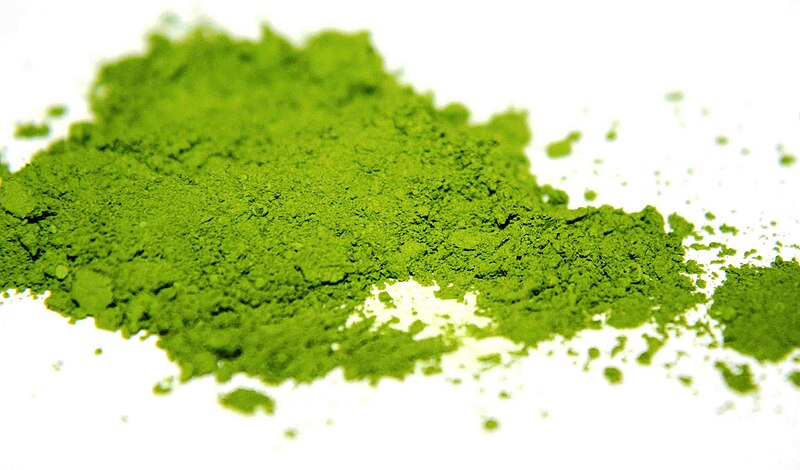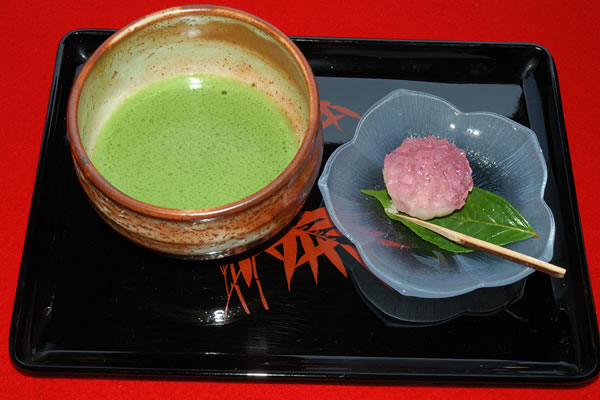
Matcha: Fine Powdered Green Tea
Photo by satorinihon / CC BY

Matcha before adding water
Photo by Matcha Tea / CC BY

Woman demonstrating Japanese Tea Ceremony
Photo by ameotoko / CC BY

Matcha and Wagashi, Japanese confectionery
Photo by Miketsukunibito / CC BY

Different types of Wagashi
Photo by mookiepix / CC BY

Matcha Blueberry Cake
Photo by vialbost / CC BY

Tea Ware: lower is Chashaku (spoon), right is chawan (bowl) and left is chasen (whisk)
Photo by Kaminix / CC BY

Whisking matcha tea with bamboo whisk
Photo by steenbergs / CC BY |
|
|
OTHER
NAMES: 抹茶 (in Japanese), maccha,
Japanese green tea
Matcha is a finely milled green tea
powder. The Japanese tea ceremony focuses on Matcha’s preparation,
serving, and drinking. [1] Because matcha can be bitter, it is traditionally served
with a traditional sweet mochi-based tea cakes. Mochi is a cake made from glutinous
rice. [2] Popular tea cakes include Daifuku (a round mochi
with sweet fillings) and Wagashi (a Japanese confectionery made with mocha, fruits, red
bean paste, and nuts.)
HISTORY
Tea
was introduced to Japan from China in the 9th century CE through a Buddhist
monk called Eichu. A few centuries later, another Buddhist monk, Eisai, brought Chinese
method of preparing powdered tea in 1191. As powdered tea preparation continued
to be an important ritual at Zen monasteries, it eventually became Japanese Tea
Ceremony. It was highly appreciated by the upper society during the 14th
century. By 16th century, many tea houses and tea gardens were built based on
tea philosophy and principle, developed by Sen
no Rikyū.
Tea drinking and its teaching also became a common practice for people in all
classes. [3]
Today,
Matcha is still an essential tea for Japanese Tea Ceremony. It also became a
popular worldwide. The flavor,
Matcha, is
being used in many modern desserts
such as Matcha chocolate, ice cream, and cake. Starbucks also introduced Matcha drinks
such as Green Tea Latte and Green Tea Frappucino. [4]
HEALTH
Matcha is beneficial to our body if we consume the right amount. According
to University of Maryland Medical Center, they recommend adults to drink around
two to three cups of green tea a day. (providing between 240 and 320 milligrams
of polyphenols.) [5]
Matcha is basically green tea, so it has so many health benefits
includes:
- protect
your body from cancer: prevent bladder, breast, ovarian, colorectal, lung,
pancreatic, prostate, esophageal, skin and stomach cancers
- help
boost your metabolism
- lowers
overall cholesterol levels
- raises the
levels of HDL, high density lipoprotein
- preventing
atherosclerosis
- promoting
alertness and mental awareness
**Please note that there is some danger associated with drinking large
quantities of Matcha (green tea) during pregnancy. It is also best to avoid drinking
it on an empty stomach because it is somewhat acidic and can cause stomach
discomfort. [6]
TEA
WARE
Special tea
equipments are used for making Matcha. First, Matcha powder needs to be sieved
and then placed into
a small tea caddy known as a chaki. By using a small bamboo tea spoon (chashaku) it
measures the powder and scoop it into the tea bowl (chawan). Note that a
Tea bowl (chawan) is used instead of a tea cup so that it is large enough
to whisk the fine powder tea with a bamboo whisk. (chasen) For tea ceremony, a tea cloth (chakin)
is commonly used for cleaning tea ware.
PREPARATION
There are two types of matcha: thin (usucha) and thick
(koicha). Thick Matcha usually uses double amount of
Matcha powder than in a thin Matcha drink. Usucha creates a lighter and
slightly more bitter tea. Koicha is normally made with more expensive
matcha from older tea trees (exceeding thirty years) and, thus, produces a
milder and sweeter tea than usucha. Koicha is served almost
exclusively as part of Japanese tea ceremonies.
For making thin tea (Usucha):
- It is prepared with approximately 1.75 grams
(around 1.5 chashaku scoop, or about half a teaspoon) of matcha
- Add approximately 75 ml (2.5 oz) of hot water per serving.
- Whisk with a chasen until no lumps left in the liquid, and no ground
tea should remain on the sides of the bowl.
For making thick tea, Koicha:
- It requires approximately 3.75 grams (3
heaping chashaku scoops, or about one teaspoon) of matcha.
- Add approximately 40 ml (1.3 oz) of hot water per serving, or as many
as six teaspoons to 3/4 cup of water.
- Because the resulting mixture is significantly thicker, blending it requires
a slower, stirring motion that does not produce foam.
|














